|

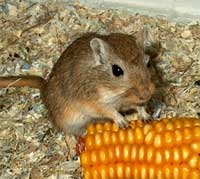
Sizes and Scales: Gerbils are typically between six and twelve inches (150 to 300 mm) long, and their tail makes up approximately one half of their total length.
One species, however, the Great Gerbil, or Rhombomys opimus, originally native to Turkmenistan, can grow to more than 16 inches (400 mm) in length.

Giant Gerbil Invaders! As of August 19, 2003, officials in western China's Xinjiang Uygur Autonomous Region began releasing eagles to combat the damage they say the Great Gerbils have done to eleven million acres (46,000 km²) of grassland.
Not So Great Gerbils: With its short fur, the Great Gerbil is the member of the family most resembling the rat. This is reported to be the worst rodent disaster to hit this region of Xinjiang in 10 years. Unless they succeed, the damage the rodents are doing could add to the steady encroachment of the desert, already occupying a vast part of the region. Great Gerbils are found in arid habitats, predominantly in sandy or clay deserts. They are found in Turkmenistan, Kazakhstan, Mongolia, China, Pakistan, Afghanistan, and Iran. The animals are often colonial, with multiple individuals inhabiting a single burrow system. Longevity is 2-4 years. Great Gerbils are known reservoirs of Yersinia the parasite that causes plague. They are also known as crop pests and have been implicated in exacerbating erosion.
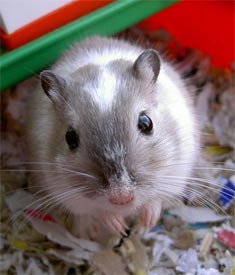 Pet Gerbils: Meriones unguiculatus is Pet Gerbils: Meriones unguiculatus is
a rodent belonging to subfamily Gerbillinae. They are the most widely known species of the Gerbil subfamily. Often called the Mongolian Gerbil or Mongolian Jird, due to its original habitat (Mongolia), it is the primary gerbil species to have been made a
pet. Similar to the hamster, it was first brought to the United States in 1954 by Dr. Victor Schwentker for use
in research.
Origin of the Pet Gerbil: Gerbils originally developed on the semi-deserts and steppes of Mongolia. There, they developed long legs for jumping and running from predators, teeth to deal with hard seeds and plant matter, and water conservation techniques that allow them to survive in the arid climate, such as storing water in layers of fat cells. Mongolian gerbils do not have many natural enemies due to the harsh climate. Most predators are birds-of-prey or snakes. Mongolian gerbils are diurnal, but return to their burrows for the coldest and hottest parts of the day.
Communal Living: In the wild these gerbils live in groups generally consisting of one parental pair and the last few litters. Only the dominant female and male produce pups. One group of gerbils generally ranges over 325 to 1550 square meters (0.08 to 0.38 acre).
The Burrow: A group lives in a central burrow with 10-20 exits. Some deeper burrows with only 1-3 exits in their territory may exist. These deeper burrows are used to escape from predators when they are too far from the central burrow. They make great pets for a first time pet owner.
First Mention: The first known mention of gerbils came in 1866, by Father Armand David, who sent "yellow rats" to the Museum of Natural History (Musée d'Histoire Naturelle) in Paris, from northern China. They were named Meriones unguiculatus by the scientist Milne-Edwards in 1867. This Latin name means "clawed warrior" in English, partly from the Greek warrior Meriones in Homer's Iliad.
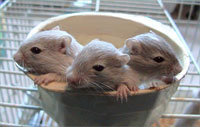 Popular as Pets: Gerbils only became popular pets after 1954, when twenty breeding pairs of gerbils were brought to the United States from eastern Mongolia for scientific testing. Almost all pet gerbils today are descended from these forty. Gerbils were brought to the United Kingdom in 1964 from the United States. Popular as Pets: Gerbils only became popular pets after 1954, when twenty breeding pairs of gerbils were brought to the United States from eastern Mongolia for scientific testing. Almost all pet gerbils today are descended from these forty. Gerbils were brought to the United Kingdom in 1964 from the United States.
Gerbils are rather popular pets, due to their gentle-towards-humans temperament and hardy nature.
Help From Friends: Because the Mongolian Gerbil is a very social creature, it is recommended that they be kept in pairs in captivity; one reason being that multiple gerbils tend to groom each other, or engage in other social activities. Therefore, gerbils generally lead poorer lives without a companion.
How to pick a gerbil: When selecting a gerbil as a pet, it is important to select a young and healthy-looking animal. Important criteria include having clear eyes, ears and nostrils, a shiny coat, and a robust body shape. Gerbils that display their inquisitive nature are a better choice than ones that prefer hanging back in a corner.
Know the Gender: When choosing your pets, it is obviously important to know their genders. This can be difficult, because it's often quite tricky trying to determine a gerbil's sex.
Typically, a male-male or female-female pairing of gerbils from the same litter is the best choice. Placing a male and a female in an enclosure will lead to an inevitable population boom, one that may tax the abilities of even experienced owners.
Also, females are somewhat more competitive with each other than males, and skirmishes may occur from time to time if two females are placed together. Usually however, the two will live together contentedly, and rarely are disputes serious enough to warrant separation of the pair.
Males placed together tend to get along quite well, and the aforementioned skirmishes are rarer between them.
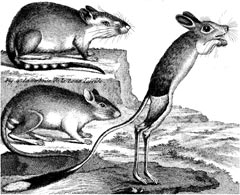 Siblings are Best: Please remember that gerbils born into the same litter are your best bet when selecting a pair. Attempting to introduce gerbils from different litters may be successful when done at a very early age. After reaching maturity however, it can be extremely difficult to get a gerbil to accept a new companion, even if they are siblings. Siblings are Best: Please remember that gerbils born into the same litter are your best bet when selecting a pair. Attempting to introduce gerbils from different litters may be successful when done at a very early age. After reaching maturity however, it can be extremely difficult to get a gerbil to accept a new companion, even if they are siblings.
Lastly, while a pair of gerbils is recommended, larger numbers can be housed together. However, enclosure size is a big factor, and trying to place three females, regardless of whether they are littermates, can be dangerous, as disputes often break out over which of the three is the dominant female.
When housing all males, three will usually live together without much or any hostility between them.
Choosing You Gerbils' Home: There are a number of options available when selecting an enclosure for gerbils. The most commonly seen are wire cages, vivariums, or tube-based habitats such as Habitrail. The best choice is usually a glass or acrylic aquarium tank, which allows a thick layer of substrate to be placed. This allows gerbils to burrow as they would naturally. An aquarium tank is also sturdy and safe, and helps alleviate problems such as drafts.
A 10 gallon aquarium tank is suitable for a pair of gerbils, although the larger 15 and 20 gallon sizes are preferable. A 20 gallon tank or larger comfortably fits three.
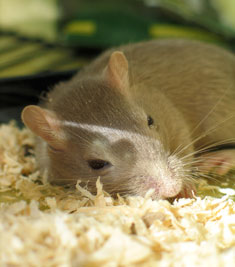 Best Bedding: Once an enclosure has been selected, the next step is to choose a substrate, or “bedding”. Choices include corncob bedding, commercially available small animal substrate, or Aspen wood shavings. Best Bedding: Once an enclosure has been selected, the next step is to choose a substrate, or “bedding”. Choices include corncob bedding, commercially available small animal substrate, or Aspen wood shavings.
Despite the ready availability and economy of Pine and Cedar bedding, you should not use it for any type of small animal. Both contain added scents, as well as toxic dust which can cause serious harm or death in many small animals.
Although the Mongolian Gerbil is a desert animal, they require fresh water at all times. Because of the gerbil’s
active nature, it would be risky to place a dish or bowl of water in an enclosure, because it would likely be knocked over or filled with bedding very quickly. Instead, use an easily accessible water bottle. Bottles are custom made fit into many types of habitats.
Gerbil Treats: Food can be given through a relatively inexpensive dry food mix, many of which are easily found at grocery and pet stores, often labeled as “Hamster and Gerbil” food. Occasionally supplementing the dry food with a select few types of fresh vegetables, like broccoli, is a good idea. However, some gerbils are finicky, and will simply ignore the offerings. When fresh vegetables or fruits are provided, be sure to clean out any uneaten portions after an hour or two. Also, some fresh produce should never be offered because of the risk of providing too much water for a gerbil's system to handle, resulting in diarrhea-like droppings.
Long in the Tooth: Gerbil teeth, like the teeth of any rodent, grow constantly, so it is highly important to provide things for them to gnaw on. This wears the teeth down, keeping their growth in check. Wooden “toys” are offered at many pet stores for this purpose. There are many other things to offer gerbils too, such as the tube from a roll of paper towels. Please make sure that the tubes do not have an excessive amount of glue, because this may potentially harm a gerbil's digestive tract.

All text is available under the terms
of the GNU Free Documentation License
|